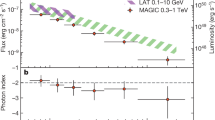Abstract
ALTHOUGH γ-ray bursts (GRBs) have been known for more than 20 years, their origin remains mysterious1. Suggestions have ranged from nearby colliding comets2 to merging neutron stars at cosmological distances3. The lack of any counterpart at wavelengths other than X-rays and γ-rays has posed a major problem in identifying the source of GRBs4. Although in principle the distribution of energies among the burst photons, as well as their light curves, may be used to constrain the potential sources, this has proved difficult in practice5. Here we present the observation of a particularly energetic burst with a duration of 90 minutes, which includes the detection of an 18-GeV photon. For comparison, typical GRBs emit photons in the energy range between a few keV and a few tens of MeV, and last a few tens of seconds6,7. The extended nature of this burst holds out the hope that there will be opportunities for telescopes operating at other wavelengths to detect a GRB source while it is still active, thus providing further constraints on the source's identity and properties.
This is a preview of subscription content, access via your institution
Access options
Subscribe to this journal
Receive 51 print issues and online access
$199.00 per year
only $3.90 per issue
Buy this article
- Purchase on Springer Link
- Instant access to full article PDF
Prices may be subject to local taxes which are calculated during checkout
Similar content being viewed by others
References
Harding, A. in The Second Compton Symposium (eds Fichtel, C., Gehrels, N. & Norris, J.) 30–39 (AIP 304, Am. Inst. Phys., New York, 1994).
White, R. S. Astrophys. Space Sci. 208, 301–311 (1993).
Eichler, D., Livio, M., Piran, T. & Schramm, D. Nature 340, 126–128 (1989).
Schaefer, B. in Gamma-Ray Bursts (eds Fishman, G., Brainerd, J. & Hurley, K.) 382–391 (AIP 307, Am. Inst. Phys., New York, 1994).
Harding, A. Phys. Rep. 206, 327–394 (1991).
Hurley, K. in Gamma-Ray Bursts (eds Paciesas, W. & Fishman, G.) 3–12 (AIP 265, Am. Inst. Phys., New York, 1991).
Kouveliotou, C. et al. Astrophys. J. 413, L101–L104 (1993).
Kippen, M. et al. IAU Circ. No. 5937 (1994).
Horack, J. & Emslie, G. Astrophys. J. 425, 776–781 (1994).
Band, D. et al. Astrophys. J. 413, 281–292 (1993).
Klebesadel, R., Laros, J. & Fenimore, E., Bull. Am. astr. Soc. 16, 1016 (1984).
Sommer, M. et al. Astrophys. J. 422, L63–L66 (1994).
Dingus, B. L. et al. in Gamma-Ray Bursts (eds Fishman, G., Brainerd, J. & Hurley, K.) 22–26 (AIP 307, Am. Inst. Phys., New York, 1994).
Mészáros, P. & Rees, M. Mon. Not. R. astr. Soc. 269, L41–L43 (1994).
Katz, J. Astrophys. J. 432, L27–L29 (1994).
Kanbach, G. et al. Astr. Astrophys. Suppl. Ser. 97, 349–353 (1993).
Thomson, D. et al. Astrophys. J. Suppl. Ser. 86, 629–656 (1993).
Hurley, K. et al. Astr. Astrophys. Suppl. Ser. 92, 401–410 (1992).
Fishman, G. et al. in Proc. GRO Science Workshop (ed. Johnson, W. N.) 39–50 (NASA Goddard Space Flight Center, Greenbelt, 1989).
Schneid, E. et al. Astr. Astrophys. 255, L13–L16 (1992).
Kwok, P. et al. in Compton Gamma-Ray Observatory (eds Friedlander, M., Gehrels, N. & Macomb, D.) 855–859 (AIP 280, Am. Inst. Phys., New York, 1993).
Author information
Authors and Affiliations
Rights and permissions
About this article
Cite this article
Hurley, K., Dingus, B., Mukherjee, R. et al. Detection of a γ-ray burst of very long duration and very high energy. Nature 372, 652–654 (1994). https://doi.org/10.1038/372652a0
Received:
Accepted:
Issue Date:
DOI: https://doi.org/10.1038/372652a0
This article is cited by
-
The golden age of high-energy gamma-ray astronomy: the Cherenkov Telescope Array in the multimessenger era
La Rivista del Nuovo Cimento (2020)
-
Ten years of AGILE: the mission and scientific highlights
Rendiconti Lincei. Scienze Fisiche e Naturali (2019)
-
GRB Observational Properties
Space Science Reviews (2016)
-
Gamma-ray bursts in the Swift-Fermi era: Confronting data with theory
Science China Physics, Mechanics and Astronomy (2010)
-
Spectral properties of Fermi/GBM gamma-ray bursts and the GeV emission detection rate with Fermi/LAT
Science China Physics, Mechanics and Astronomy (2010)
Comments
By submitting a comment you agree to abide by our Terms and Community Guidelines. If you find something abusive or that does not comply with our terms or guidelines please flag it as inappropriate.



